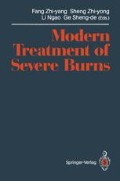Abstract
Skin is the largest organ in the body and serves as an extensive protective covering of the body surface. It is multilayered, with the cornified cells as the outermost layers on top of the viable epithelial cells to form the superficial protective layer, while the epithelial cells, which are closely bounded, form the deep protective layer. The protective function of the skin as maintained by its multilayered structure is as a mechanical barrier to keep out the invading microorganisms. The natural flora of the skin serves as a preventive measure against the colonization of pathogenic microorganisms. The integrity of the mechanical barrier of the skin is disrupted by burn injury, when the wound surface is inevitably contaminated by microorganisms, with ensuing infection of the local burn wound.
Access this chapter
Tax calculation will be finalised at checkout
Purchases are for personal use only
Preview
Unable to display preview. Download preview PDF.
References
Tian FQ, Cuei JY, Yu FZ (1987) The major reasons of fatality in burns — analysis of 308 cases. Chin Emerg Med 7(3): 6–10
Dietch EA, Berg R, Specian R (1987) Endotoxin but not malnutrition promotes bacterial translocation of the gut flora in burned mice. Arch Surg 122: 185–190
Kim SH, Mason AD, Okerberg CV et al. (1989) Viral infection in burn patients: a review of seven-year autopsies. Proceedings of the 2nd Sino-American conference on burn injury and trauma, p 82
Yang FX (1989) Clinical observation of cold wet soaking using chlorhexidine on burn wound. J Pract Surg (Chin) 9: 52–54
Xu FX (1985) Management of deep burn wound. In: Fang ZY et al. (eds) Handbook of burn treatment, 3rd edn. Shanghai Publishers of Science and Technology, Shanghai, pp 118–119
Woolfrey BF et al. (1981) An evaluation of burn wound quantitative microbiology. I. Quantitative eschar culture. Am J Clin Pathol 75(4): 532
Zhang YP, Li A, Wang DW et al. (1988) Dynamic observation of invasive pyocyaneous infection in scalded rat. Chin J Exp Surg 5: 109–110
Tian FQ, Cuei JY, Yu FZ etal. (1985) Clinical and laboratory study of bacterial invasion in deep burn tissue. Chin J Plast Surg Burns 1: 289–291
Qin XJ, Wang DW, Zhang YP et al. (1989) Evaluation of forecasting bacterial count of burn tissue homogenate using smear staining technique. Chin J Plast Surg Burns 5: 45–46
Pruitt BA Jr, Foley FD (1973) The use of biopsies in burn patient care. Surgery 73: 887–897
Kim SH (1985) A rapid section technique for burn wound biopsy. JBCR 6: 432–435
Kim SH, Hubbard GB (1985) Frozen section technique to evaluate early burn wound biopsy: a comparison with the rapid section technique. J Trauma 25: 1134–1137
Holder IA (1986) Norfloxacin and silver-norfloxacin as topical anti-microbial agents: results of in vitro susceptibility testing against bacteria and Candida SP isolated from burn patients. JBCR 7: 479
Ge SD, Huo ZL, Tu SZ et al. (1987) The effect of quinolones as topical antibiotics on the prevention and treatment of pyocyaneous infection following burn. Chin J Plast Surg Burns 3: 10–13
Ge SD, Huo ZL, Gu B et al. (1989) Evaluation of water, electrolyte, and acid-base imbalance in major burns. Proceedings of the 2nd Sino-American conference on burn injury and trauma, Beijing, p 5
Brcic A (1978) The value of topical chemotherapy with Dermazin in the treatment of extensive burns by primary necrectomy. Lek Pharmaceutical and Chemical Works, Ljubljana
Ge SD, Fang ZY, Tu SZ et al. (1982) N’-metal sulfa drugs and zincpolyanemine and its derivatives in prevention of burn wound sepsis. Chin J Surg 20: 264
Lindberg RB (1965) The successful control of burn wound sepsis. J Trauma 5: 601
Hunt JL, Sato R, Heck EL et al. (1980) A critical evaluation of povidine-iodine absorption in thermal injured patients. J Trauma 20: 127–129
Editor information
Editors and Affiliations
Rights and permissions
Copyright information
© 1992 Springer-Verlag Berlin Heidelberg
About this chapter
Cite this chapter
Sheng-de, G. (1992). Management of Local Burn Infection. In: Zhi-yang, F., Zhi-yong, S., Ngao, L., Sheng-de, G. (eds) Modern Treatment of Severe Burns. Springer, Berlin, Heidelberg. https://doi.org/10.1007/978-3-642-76623-7_9
Download citation
DOI: https://doi.org/10.1007/978-3-642-76623-7_9
Publisher Name: Springer, Berlin, Heidelberg
Print ISBN: 978-3-642-76625-1
Online ISBN: 978-3-642-76623-7
eBook Packages: Springer Book Archive

